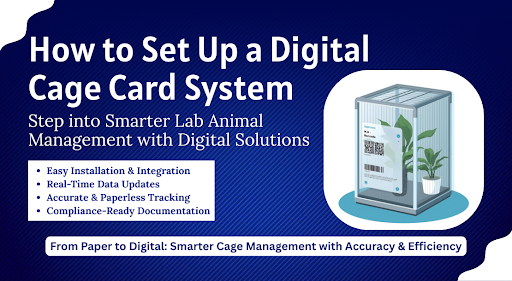
12 Sep How to Set Up a Digital Cage Card System
In today’s animal research laboratory environments, effectiveness, accuracy, and compliance
are the priorities. The one laboratory improvement with the greatest positive impact is the shift
from handwritten paper-based records to an electronic cage card system. Not only is this time-
saving, but it also decreases errors, improves communication, and optimizes compliance with
regulations. Leaders in solution in this area are Cage Talkers, a state-of-the-art digital solution
to streamline and keep cage documentation current.
This blog discusses why digital cage card systems are important, how to adopt them, and how
solutions such as Cage Talkers can transform lab operations.
Why Switch to a Digital Cage Card System?
Paper cage cards have sat in laboratories for centuries, containing information such as animal
ID, study details, and treatment plans. However, they are prone to limitations such as:
● Handwritten mistakes and misreadings
● Lost or ancient information
● Physical card loss or deterioration
● Limited access by the majority of staff
In contrast, an electronic cage card system offers:
● Real-time updates of information
● Centralized data management
● Elimination of errors through auto-inputting
● Easy integration with laboratory information management systems
Improved compliance and audit readiness
With such applications as Cage Talkers, labs can have precise and easily retrievable
information on hand at the cage level, making efficiency and reliability a reality.
Step 1: Determine Your Laboratory’s Requirements
You should determine your facility’s particular requirements prior to installing a digital cage card
system. Ask yourself the following questions:
● Number of animal rooms and cages to be managed
● Regulatory and compliance needs
● Integration with other lab management software applications
● Individual workflows for experiments, treatment, or breeding
This planning ensures that the system you put in place is scalable to the size and scope of your
lab.
Step 2: Choose the Right Digital Solution
Not all electronic cage card systems are the same. Choose solutions that offer:
● Easy-to-read electronic displays
● Wireless data transmission to allow for rapid updates
● Incorporation into lab management systems
● Scalability to accommodate the expansion of operations
Cage Talkers stand at the forefront of this segment. Designed for animal research facilities, they
replace cumbersome paper cards with smart electronic displays that integrate seamlessly with
centralized databases.
Step 3: Install and Set Up the Installation Plan
After selecting your system, the next step involves planning carefully:
Infrastructure Readiness – Have your lab equipped with the necessary wireless network or
connectivity.
Hardware Installation – Where Cage Talkers or digital displays are to be installed on racks and
cages.
Software Integration – Get the digital cage card system integrated into your lab’s current
management software to facilitate data exchange easily.
Advanced planning minimizes disruption and enables a smooth transition.
Step 4: Train Your Team
Even the most flawless digital cage card system requires training. Staff members must be
comfortable with:
● Maintenance of up-to-date records in the system
● Reading data displayed on Cage Talkers
● Solving small issues
● Compliance via electronic records
● Training standardizes and maximizes the potential of the new system.
Step 5: Implement and Monitor
Once installed, begin rolling out the system in stages. Put in a pilot program in one area of your
plant to find where the issues are, and then roll it out in stages. Monitor the system for accuracy,
efficiency improvements, and feedback from users.
Cage Talkers generates updates in real time at the cage level, cutting out mistakes and minutes
from audits or inspections. Monitoring this improvement streamlines procedures and
demonstrates the value of the system.
Advantages of Employing Cage Talkers for Electronic Cage Cards
The use of Cage Talkers for cage records has numerous valuable advantages:
Real-Time Updates: Synchronized data across devices automatically.
Compliance Support: Traceable electronic records ready for audits.
Error Reduction: Automatically posted items cut down on human error.
Efficiency: Staff spend less time logging and more time conducting research and caring for
animals.
Scalability: Ideal for small laboratories and large animal research centres.
These benefits render Cage Talkers a valuable asset to labs that wish to automate cage
reporting.
The Future of Cage Documentation
While laboratories become more digital, digital cage card systems will be the new normal. The
collision of technologies like AI, sensors, and automation with systems like Cage Talkers will
also increase efficiency and accuracy, with laboratories set to provide evolving research
requirements.
Conclusion
Implementation of an electronic cage card system is among the strongest means for placing
laboratory processes in the contemporary era. From reducing human error to automating
regulation, electronic systems dramatically improve efficiency and reliability. Using advanced
tools like Cage Talkers, laboratories are able to create a more brilliant, more accurate, and
future-proofed cage record system that maintains research excellence as well as supports
animal welfare.


